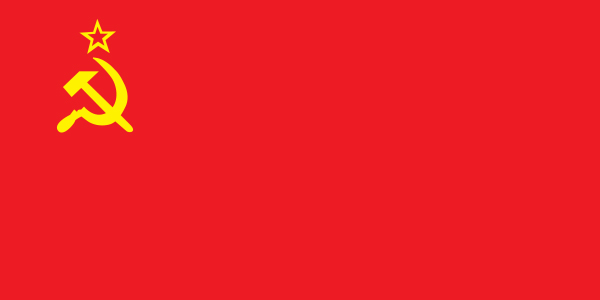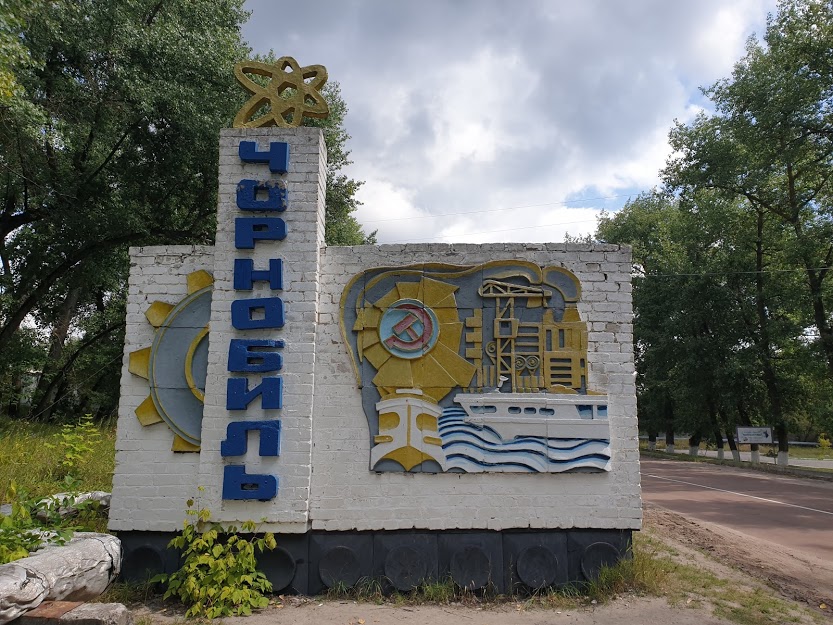During the Soviet Union and today, the Chernobyl region and Pripyat didn’t have a specific flag to represent it. Instead, they went under the flags of the Ukrainian and Belarussian Soviet Socialist Republics and subsequently the current flag of Ukraine and Belarus. In this section, we’re going to look at these two historic flags of Chernobyl and the coat of arms of Pripyat that dates back to the Soviet Union.
Flag of the Ukrainian Soviet Socialist Republic
Between 1919 and 1949, Ukrainians were extremely picky with their choice of national flags and changed it around every decade. All were based on the red flag of the October Revolution in Russia but it was only until 1949 that a more stable design was adopted that consisted of a red background, an azure blue stripe, and a golden hammer, sickle, and star in the top left corner. Through this new flag, the Soviets managed to grab two extra seats in the UNI by adding Ukraine as well as Belarus, both Soviet satellite states, as members.
Flag of the Belarussian Soviet Socialist Republic
The flag of the Byelorussian Soviet Socialist Republic was adopted on December 25, 1951. Before this, the flag was red with the characters BSSR in golden Cyrillic in the top-left corner, surrounded by a gold border. Between 1937 and the adoption of the above flag in the 1940s, the flag was the same, but with a gold hammer and sickle above the Cyrillic characters and no border. Between 1919 and 1937, the flag was red, with the characters SSRB in Cyrillic in the top left-hand corner. In early 1919, a plain red flag was used. The final BySSR flag was used until the collapse of the Soviet Union in 1991. A flag based on this design is used as the current national flag of Belarus.
The flag of the Soviet Union

During the Chernobyl disaster, the flag that was raised over the sarcophagus was not the flag of the Ukrainian SSR but was instead the flag of the Soviet Union. This was because defeating the menace of the Chernobyl disaster saw emergency workers being bussed in from various corners of the USSR and thus, the subsequent victory was attributed to the Soviet nation as a whole and not just Ukraine.
The flag of the Soviet Union is one of the most easily recognizable flags on earth. Its symbolism has gone on to be used in countless methods, from selling capitalist products to communist guerillas, long after the USSR collapsed. Today, we’re going to look into the story of the flag of the Soviet Union.
The design and symbolism of the flag of the Soviet Union all emerged during the Russian Revolution. The flag is also an international symbol of the communist movement as a whole. The nicknames for the flag were The Hammer and Sickle and The Red Banner.
The red flag that formed the backdrop of the flag was a traditional revolutionary symbol long before the Russian revolution in 1917. Its incorporation into the flag paid tribute to the international aspect of workers’ revolution. The color red honors the red flag of the Paris Commune of 1871.
The iconic hammer and sickle design was a modern industrial touch adopted from the Russian Revolution. The union of the hammer (workers) and the sickle (peasants) represents the victorious and enduring revolutionary alliance. The famous emblem is topped by a gold-bordered red star representing the Communist Party of the Soviet Union.
During the Russian Soviet Republic’s establishment, Vladimir Lenin and his comrades had considered the inclusion of a sword symbol in addition to the hammer and sickle as part of the state seal on which the flag was eventually based. The idea was dismissed as too visually aggressive, with Lenin apparently affirmed, “A sword is not one of our symbols.”
The coat of arms of Pripyat
The model city of Pripyat was a crown in the jewel of the Soviet Union. Those fortunate enough to live there enjoyed a quality of life rarely seen in various other parts of the Soviet Union. That quality of life came at a deadly price, however, when the Chernobyl disaster took place in 1986. As we already discussed, the city of Pripyat didn’t have a flag of its own, but it did have a pretty cool coat of arms!
The symbolism of Pripyat focused largely around science, engineering, and industry, as that was what the city was famous and subsequently infamous for. The coat of arms of Pripyat features the logo of the Chernobyl Nuclear Power Plant, a hammer and sickle, and a traditional local flower. The blue represents the Pripyat River.
The current flag of Ukraine
Today, the Ukrainian sector of the Chernobyl exclusion zone is represented by the current Ukrainian flag which consists of two horizontal bands of yellow and blue. The colors represent the wide blue skies and the yellow represents the wheat fields that characterize the country. From a psychological point of view, blue symbolizes calm, whilst yellow symbolizes joy. The current color combination has its roots in the 12th-century flag of the Galicia–Volhynia kingdom. Officially, the flag was first used as a state flag in 1918 when it was officially adopted by the short-lived West Ukrainian People’s Republic and then used by the Ukrainian People’s Republic.
Like Russia, when Ukraine fell under the control of the Bolsheviks the national blue and yellow flag was outlawed. It was only until 1949 that the country adopted the Ukrainian SSR flag which remained the flag of state until 1991 when the country gained independence after the collapse of the Soviet Union and the yellow and blue flag was restored in 1992.
The current flag of Belarus
Today, the Belarusian sector of the Chernobyl zone is represented by the modern flag of Belarus which is a red-and-green flag with a white-and-red ornament pattern placed at the staff end. The current design was introduced in 2012 and is adapted from a design approved in a referendum in May 1995. It is a modification of the 1951 Soviet-era flag. Changes made to the Soviet-era flag were the removal of symbols of communism such as the hammer and sickle and the red star and the reversal of the colors of the ornament pattern, from white-on-red to red-on-white.












